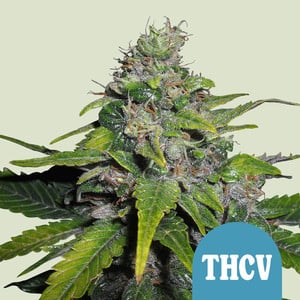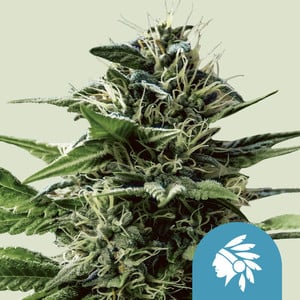.

Cannabis Shakes: Causes, Remedies, and How to Avoid Them
Scared by cannabis shakes? Don't be—in almost all cases, shaking after consuming cannabis is a harmless response to the negative side effects of weed's active compounds. Read on to learn everything you need to know about the cannabis shakes with our comprehensive guide.
Contents:
Key Points:
- Using cannabis can occasionally cause shaking or tremors in some people. This is colloquially known as the "cannabis shakes".
- Twitching while high can be unpleasant and worrying. However, cannabis shakes are usually short-lived and not serious.
- Shaking after smoking weed is usually a response to consuming too much THC. The tremors should subside rapidly as your body metabolises the THC.
- THC can temporarily affect the body's ability to regulate its temperature, making you more sensitive to cold temperatures. Moreover, THC is also known to cause anxiety in some people.
Many smokers have been there; you hit a joint or bong and, minutes later, notice that your limbs or other body parts are shaking. But what causes you to twitch while high? In most cases, weed shakes are unpleasant but harmless, and will subside as your high wears off. So if you're reading this while stoned and shaking, you can relax. Jittering while high is usually the result of simply consuming too much THC, which can admittedly be overwhelming and anxiety-inducing.
Occasionally, cannabis shakes may also be triggered by the environment in which you're smoking. Keep reading to learn everything about weed shakes, why they happen, and how to deal with them when they strike.
What Are Cannabis Shakes?
"Cannabis shakes" are involuntary twitches or tremors that occur directly after smoking cannabis. While they can conjure up images of Trainspotting or Requiem for a Dream, the weed shakes are usually harmless and simply a response to consuming too much THC. They are most common in inexperienced users or people with a low tolerance/high sensitivity to cannabis' active compounds. However, more seasoned users can also experience weed shakes when trying out new, more intense methods of consumption such as dabbing or edibles.
Though it's uncomfortable, twitching while high is usually harmless and short-lived. In most cases, weed shakes wear off quickly as you calm down and your high subsides.
Why Do You Shake After Smoking Cannabis?
Stop wondering—here are the four main causes of cannabis shakes.
-
Cooler Body Temperature
The endocannabinoid system is a complex signalling system that controls many bodily functions, including body temperature. Animal studies have shown that phytocannabinoids like THC can cause changes in our body temperature—though claims that weed can cause hypothermia are blown out of proportion. This has only been observed in mice that were given extremely high doses of THC (up to 8 mg per kilogram of body weight).
These same mice also showed decreases in spontaneous movement[1] when given at least 2 mg of THC per kg of body weight. To any of you reading this while baked on the couch, this will come as little surprise. Moreover, the same study also shows that THC can cause temporary temperature decreases in the brain and muscles. This drop in basal body temperature might be enough to cause your cannabis shakes, especially if you're already smoking in a cold environment or are susceptible to cold temperatures.
-
Overstimulation
Cannabis has a substantial effect on our senses. It affects our olfactory response and vision, and has the potential to enhance our experience when listening to music. Moreover, many cannabis consumers report that weed greatly increases their sensitivity to touch.
For many of us, smoking cannabis leaves us feeling more sensitive—ideal when we want to connect with people or activities on a deeper level. At the same time, this increased sensitivity to stimuli can make it easy to feel overwhelmed and overstimulated, which in turn can cause shaking or nervousness. You may have experienced this when consuming cannabis in very stimulating environments, such as concerts, nightclubs, theatres, or large, crowded parties.
In some parts of the world, it's also commonplace to consume cannabis together with tobacco. This can also cause overstimulation, as the nicotine in tobacco is a well-known stimulant. Especially for people unaccustomed to smoking tobacco, the added punch of nicotine can make for an overwhelming head rush that can cause nervousness and, as a result, twitching or shaking.
-
Anxiety
Cannabis and anxiety have a complicated relationship. For every smoker who loves to wind down with a few tokes, there's one who finds cannabis to be capable of inducing utterly gut-wrenching bouts of anxiety or even panic attacks that leave them shaking with fear. In most cases, this comes down to your sensitivity to or tolerance for THC.
THC binds to CB1 receptors in the brain because its structure mimics that of endocannabinoids like anandamide and 2-AG. When it does, it causes an increase of dopamine—a neurotransmitter best known for causing feelings of pleasure, satisfaction, and motivation. At the same time, THC also directly affects the activity of the amygdala—a part of our brain tasked with processing emotions such as fear and analysing/perceiving threats.
In small to moderate doses, THC seems to reduce threat perception[2]. In higher doses, however, THC can exacerbate specific activity in the amygdala and thereby cause anxiety[3]. Moreover, some research also suggests that prolonged cannabis use can downregulate receptors in the amygdala[4], which may also make people more prone to anxiety in general.
-
Too Much THC
To go back to the original question: are the shakes just a side effect of getting way too high? Often, the answer is yes. We've all flown too close to the sun at some point, but nobody has died from overdosing on cannabis alone[5]. Freaked out and embarrassed yourself in front of all your friends? That's another story.
Unfortunately, quantifying “too much THC” is complicated. Some smokers spend all night blazing and remain as cool as a cucumber. For many others, however, one toke too many can be all it takes to turn a chill session into a night out with Tito the Anxiety Mosquito.
Of course, different methods of consumption can also trigger anxiety and cannabis shakes—even in people with a decent tolerance. Edibles or dabs, for example, are extra potent and can deliver a lot of THC into your system at once. Hence, even if you're a seasoned smoker, it's usually a good idea to take it easy when trying edibles, dabs, or even just high-potency flower for the first time. After all, it's a good time we're chasing when indulging in weed, not a kick to the curb.
The cannabis shakes are commonly due to a mild THC overdose. Don't let the word "overdose" freak you out too much, especially if you're young and healthy.
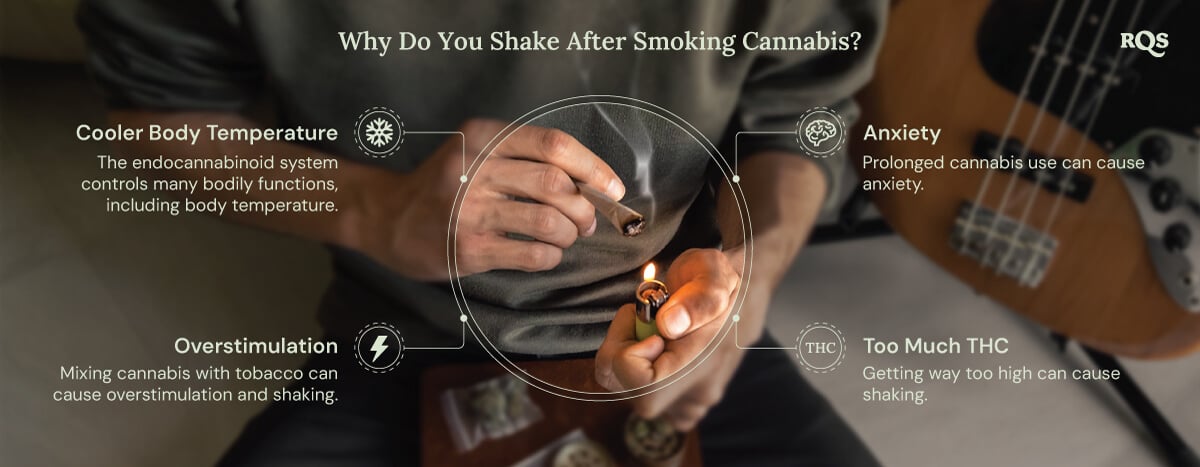
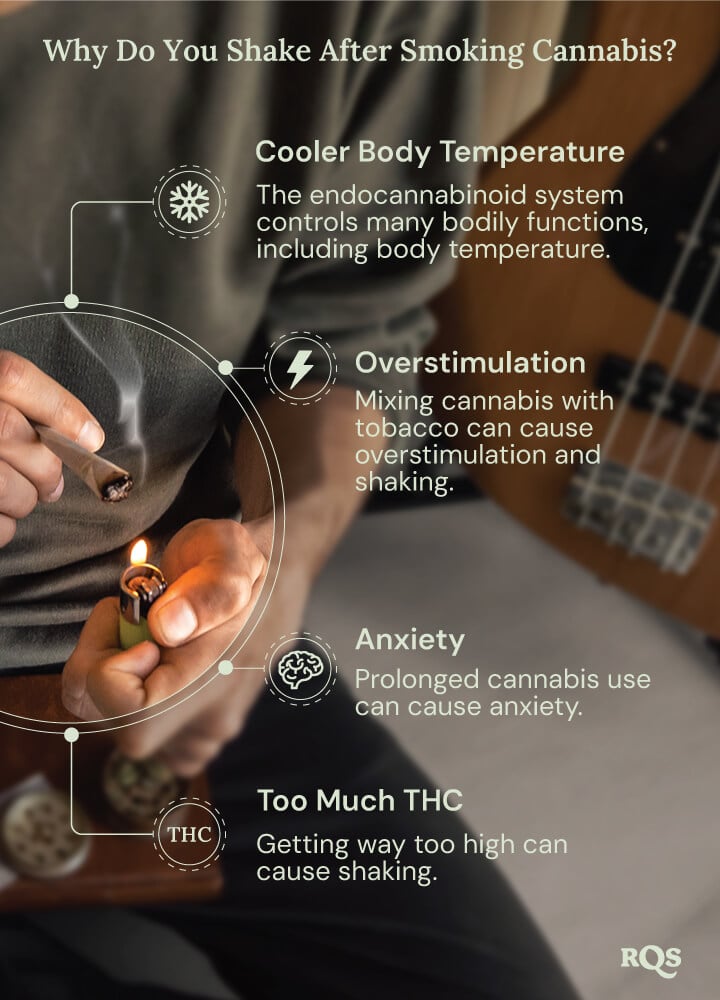
Can Weed Shakes Be Dangerous?
If you've found yourself shaking after smoking weed, it's understandable that you're worried. However, rest assured—most cases of cannabis shakes are harmless and will wear off as soon as you calm down and your high dissipates.
The only time you should worry about weed shakes is when they come accompanied by other, more severe symptoms, such as:
- Chest pain or extreme tachycardia
- Delusions or paranoia
- Fainting
- Memory loss
- A notable loss of cognitive or motor function
As we've said multiple times, shaking after consuming cannabis is usually harmless and has happened to many stoners. In very extreme and rare cases, however, weed shakes may be associated with some kind of underlying health condition. But remember—we're not doctors, and this article isn't designed to give medical advice. So, if you're worried about your health after twitching while high, speak to your healthcare professional for more information.
What Can You Do if You Get the Cannabis Shakes?
Time is your biggest ally when it comes to shaking the weed jitters. However, since cannabis shakes can be alarming and uncomfortable, simply waiting for them to pass isn't always an option. Hence, here are a few things you can do to ease your mind and relieve trembling from smoking weed.
-
Adjust Your Environment
We mentioned earlier that cannabis has a notable effect on our senses, and your environment can have a big impact on your experience with weed. If you happen to experience nervousness or shaking after getting high, making some slight adjustments to your surroundings might be all it takes to steer the ship in the right direction. Consider:
- Changing the music: There's no universal guide to picking music for your sessions, so play whatever genre you enjoy and that you feel is going to maximise your chances of having a good time.
- Changing the lighting: Light has a big impact on our mood and energy levels. Whether you prefer dim, warm lights or a brighter atmosphere, the proper lighting for your session can greatly improve your cannabis experience.
- Social settings: For many people, cannabis is the perfect social lubricant. For others, however, it offers a more introspective experience that's best enjoyed alone. Learn to recognise the way in which you most enjoy cannabis, and set up your session accordingly—alone, with close friends, or with a house full of guests!
-
Move Around, Distract Yourself, and Breathe
Feeling the shakes coming on? Shake them off by getting up, moving around, and breathing deeply. As we mentioned earlier, cannabis may reduce spontaneous movement and basal body temperature.
Getting up and moving around a little can help warm up your body, while some concentrated breathwork can help keep your body well-oxygenated.
Sometimes, a bit of light physical activity can not only shake the weed jitters but even take your session to new heights! Yoga, stretching, walking, or playing leisurely sports (like catch or table tennis) are some light physical activities that can elevate your session. Be sure to give them a try.
-
Stay Away From Stimulants
Generally speaking, we recommend not mixing cannabis with other drugs, as the interplay between their active compounds can create an overwhelming experience. Stimulants, in particular, often don't pair well with weed, especially stimulants that you're not accustomed to.
Nicotine, caffeine, or energy drinks can create a very intense kick of energy that, when combined with the mental euphoria of some strains, can trigger anxiety in some people. Alcohol, though a depressant, also doesn't pair well with cannabis—for many, mixing booze and weed can create an intense, messy buzz.
If you want to pair your weed with something, try:
- Decaf coffee or coffee alternatives (such as those made from mushrooms, chicory, maya seed, or dandelion)
- Caffeine-free herbal teas
- Fruit juices or smoothies
- Nicotine-free herbal smoking blends (a great alternative to tobacco)
-
Switch Strains
Regularly twitching after smoking the same weed? Maybe it's time to switch up the strain you're smoking. For some, uplifting and euphoric strains can become overwhelming, producing racing thoughts and hyperactivity. Meanwhile, others might struggle to cope with the warming, physical body buzz of other varieties.
While cannabis users have long used the terms indica and sativa to guide their strain choices, we now know that these terms actually tell us very little about a strain's effects. Instead, they describe a cannabis plant's morphological traits and genetics. To get a better idea of the effects of a strain, consider its chemical profile, particularly its concentration of cannabinoids and terpenes (see more below).
-
The Alternative: CBD
Another way to combat cannabis shakes is by taking CBD. Research shows that cannabinoids like CBD and others (including THCV) can potentially reduce the intoxicating effects of THC. More specifically, studies have shown that, in the presence of THC, compounds like CBD can potentially work as an antagonist of CB1 receptors[6]—the main target for THC. In doing so, it's able to reduce the potency and efficacy of not only THC but even THC-like endogenous compounds such as anandamide.
So, if you're prone to shaking after smoking, consider taking some CBD during your session. Tinctures or gummies are super easy to dose and administer sublingually, but keeping a CBD vape handy can also work very well and deliver more immediate relief.
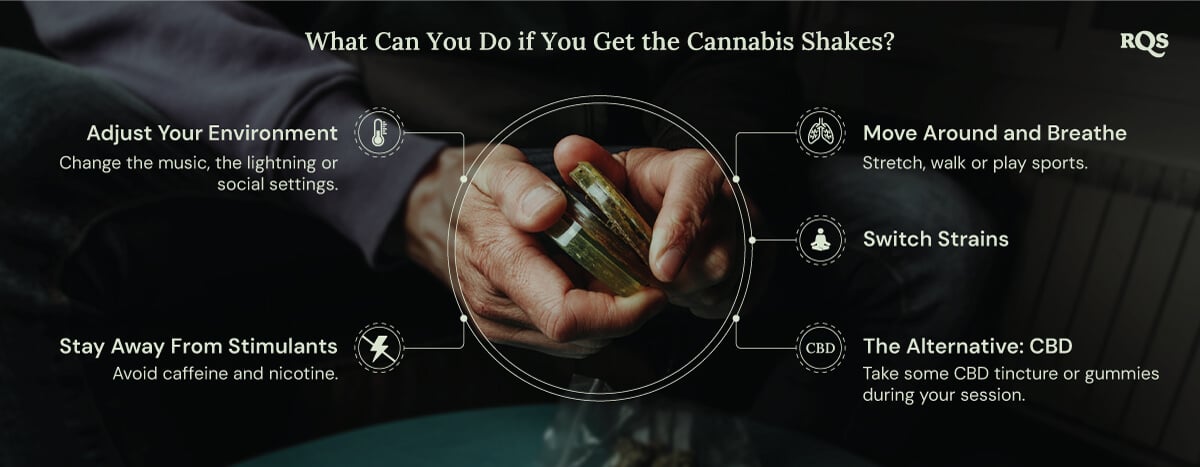
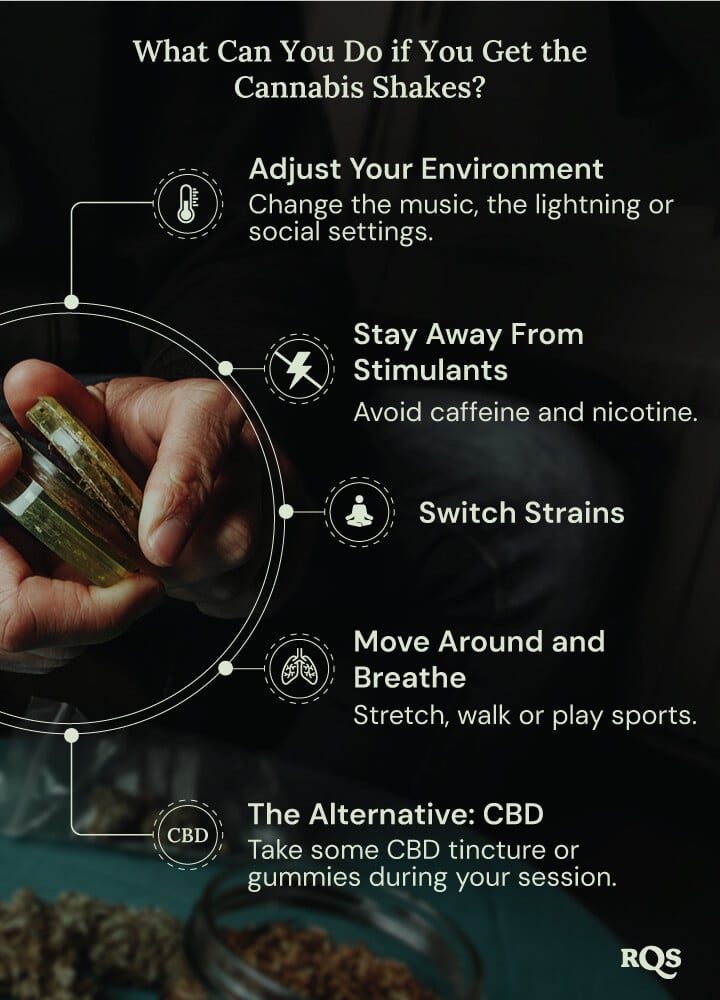
How Long Do the Cannabis Shakes Last?
Cannabis shakes are usually short-lived. However, their exact duration will depend on how much cannabis you took and how you consumed it. Smoking or vaping, for example, produce a fast onset of effects.
Hence, if you find yourself twitching after one too many hits from your joint, bong, or vape, you should feel better within 15–20 minutes.
Edibles, however, produce a slower onset but a prolonged effect. Ingested cannabis can take 40+ minutes to take effect and can produce a high that lasts several hours. To avoid dealing with prolonged shakes after eating weed, it's super important you learn how to dose your edibles properly.
Besides proper dosing, some ways to tackle the shakes from edibles include:
- Taking some form of fast-acting CBD before taking an edible (or at least at the same time), such as a CBD vape
- Staying hydrated
- Creating a relaxing environment
- Seeking help from a friend (preferably someone who's not high)
- Remembering to stay calm—the shakes will soon wear off
How to Prevent Cannabis Shakes
Knowing how to stop shaking after smoking is pretty handy. But knowing how to prevent cannabis shakes altogether is priceless. Of course, everybody is different—remember that everyone experiences weed a little differently based on their own body chemistry and experiences. Nonetheless, the tips below should help you prevent weed tremors and ensure an all-round enjoyable experience.
-
Moderation Is Key
We can't drive this point home enough; your cannabis experience is directly related to how much you consume. Hence, taking the time to dose your weed properly is crucial to having an enjoyable experience and avoiding unwanted side effects such as shaking.
Unfortunately, since peoples' sensitivity to cannabinoids can vary so greatly, it's not enough to simply follow a dosing guide you pulled off the internet (though our dosing tips are a great place to start). Instead, you'll want to familiarise yourself with your body's response to cannabis and moderate your intake that way. This is especially important if you're new to weed, or if you suffer from cannabis shakes or other side effects frequently—a sign that you may be very sensitive to cannabis compounds.
When it comes to dosing cannabis, there's one golden rule—start low and go slow, especially if you're just getting started or coming back from a tolerance break. Start with small doses, gauge your reaction, and up your dose as needed till you find that sweet spot. Remember that you can always take more if you're not quite feeling it, but it's impossible to get weed out of your system once you've taken it, other than waiting for your body to metabolise it.
-
Mindful Consumption
Mindful consumption is all about becoming more conscious of how and when you consume cannabis. Rather than sparking up a jay whenever you please, consider planning your sessions with a bit more foresight. This way, you'll be able to prepare for your next smoke by taking care of your errands and responsibilities first, and maybe even set up that perfect environment we mentioned earlier.
Moreover, consider not smoking when you know you'll be drinking or at times when you might be consuming a lot of stimulants—such as along with your afternoon coffee, for example. That way, you'll be able to really savour your weed and its effects at times when you're truly "feeling it", rather than letting smoking become just another habit.
-
Choose the Right Strain
One of the best ways to ensure you have an enjoyable experience with cannabis is—drumroll please—by smoking the right strain. But don't fall into the trap of making your strain choices based on the outdated folklore that "sativa is uplifting and indica is relaxing". Instead, consider the following:
- Cannabinoids: High-THC strains are the most intoxicating and are more likely to cause anxiety at high doses or in users with a low tolerance. If you get the shakes from high-THC cultivars, consider trying strains with a more balanced cannabinoid profile that includes more soothing compounds such as CBD, THCV, and CBG.
- Terpenes: Apart from giving different strains their unique aromas and flavours, terpenes are also known to influence cannabis effects in particular ways. Like cannabinoids, some terpenes can be more energising and uplifting, while others can be more soothing. Myrcene and linalool, for example, are often touted for having more relaxing properties; pinene is often associated with producing a clear-headed, lucid effect, and limonene is thought to produce the stimulating, energising properties most people traditionally associated with sativa strains. Learn more about the effects of different cannabis terpenes here.
If you've been suffering from the cannabis shakes, fear not—there's no shortage of varieties for you to experiment with. Some strains that are less likely to cause tremors or shaking may include:
- Painkiller XL: Bred from Juanita la Lagrimosa and Royal Highness, Painkiller XL boasts a short flowering time, compact stature, and high yields. Better yet, her balanced cannabinoid profile features 9% THC and similarly high levels of CBD—ideal for inducing a balanced effect that soothes the body and mind without causing anxiety, stress, or other similar side effects.
Painkiller XL
|
|
Respect 13 x Juanita la Lagrimosa |
|
|
500 - 550 gr/m2 |
|
|
60 - 100 cm |
|
|
8 - 9 weeks |
|
|
THC: 9% |
|
|
Sativa 75% Indica 25% |
|
|
500 - 550 gr/plant |
|
|
120 - 150 cm |
|
|
Late September |
|
|
Clear, Physically Relaxing |
- Royal THCV: As her name suggests, this strain comes packing high concentrations of tetrahydrocannabivarin—a cannabinoid that's known to produce euphoria but also dampen the effects of THC. Enjoy this strain early in the morning, during the day, or whenever else you want a motivating buzz without feeling overwhelmed.
Royal THCV
|
|
Pure African Sativa x Durban Haze |
|
|
500 - 550 gr/m2 |
|
|
80 - 120 cm |
|
|
9 - 10 weeks |
|
|
THC: 7% |
|
|
Sativa 95% Indica 5% |
|
|
425 - 475 gr/plant |
|
|
140 - 180 cm |
|
|
Late October |
|
|
Clear, Motivating , Uplifting |
|
|
7% |
- Tatanka Pure CBD: The flagship of our CBD strain catalogue. Bred with medical users in mind, Tatanka Pure CBD delivers 9–14% CBD and produces none of the intoxicating effects you'd normally get from a THC strain. Enjoy this one worry-free at any time of the day and bask in its clear-headed, soothing effects.
Tatanka Pure CBD
|
|
Elixir Vitae x Medical CBD |
|
|
400 - 450 gr/m2 |
|
|
80 - 100 cm |
|
|
6 - 8 weeks |
|
|
THC: 0,15 - 0,25% |
|
|
Sativa 30% Indica 70% |
|
|
400 - 450 gr/plant |
|
|
100 - 160 cm |
|
|
Early October |
|
|
Calming, Clear |
-
Prepare Your Body
One final way to ward off the cannabis shakes is by preparing your body for a smoking session. In most cases, simply staying hydrated and eating some healthy, nutrient-dense food (like fruits) before lighting up is enough. This will help stabilise your blood sugar levels, keeping you feeling great from the moment you light your jay until you've burned it down to the roach.
FAQ About Cannabis Shakes
- Can mouldy or expired weed cause shakes?
- Cannabis shakes are usually caused by consuming too much THC, which can be overwhelming and anxiety-inducing. Nonetheless, never smoke mouldy or expired weed, as this can expose you to a host of other issues. Learn more about the risks of mouldy weed here.
- Are weed shakes more common with certain consumption methods?
- Yes, weed shakes may be more common with consumption methods that introduce more THC (or stronger forms of THC) into the body more quickly. Dabbing powerful extracts or eating potent edibles, for example, may put you at a higher risk of cannabis tremors than more traditional methods such as smoking/vaping flower.
- How does CBD help with cannabis shakes?
- CBD may help relieve or prevent cannabis shakes by reducing the intoxicating effects of THC. CBD does this by hindering the ability of THC to bind to cannabis receptors.
- Is it normal to feel cold or shiver after smoking cannabis?
- Yes! THC can reduce basal body temperature, making you feel colder than normal.
- What is the connection between anxiety and weed shakes?
- Most of the time, shaking after smoking weed is a side effect of consuming too much THC, which can cause an unpleasant, anxious experience in people, as well as overstimulation. Combined, these side effects can cause shaking and tremors.
- Is it normal to twitch when high?
- While it's definitely not desired, twitching after consuming too much cannabis is fairly common. Unless it's accompanied by severe symptoms like delusions, paranoia, or fainting, shaking after smoking weed is nothing serious and little to worry about.
- Behavioral and temperature effects of delta 9-tetrahydrocannabinol in human-relevant doses in rats - PMC https://pmc.ncbi.nlm.nih.gov
- Cannabinoid Modulation of Amygdala Reactivity to Social Signals of Threat in Humans - PMC https://pmc.ncbi.nlm.nih.gov
- Acute induction of anxiety in humans by delta-9-tetrahydrocannabinol related to amygdalar cannabinoid-1 (CB1) receptors | Scientific Reports https://www.nature.com
- https://www.psychologytoday.com/intl/blog/the-athletes-way/201403/cannabis-targets-receptors-in-the-amygdala-linked-to-anxiety
- Can you overdose on weed? Here's the science. | Popular Science https://www.popsci.com
- Frontiers | Cannabinoids and Pain: New Insights From Old Molecules https://www.frontiersin.org



























